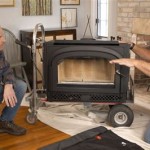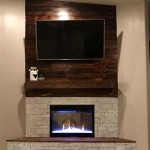Cost To Fix a Fireplace Damper
A functioning fireplace damper is crucial for both the efficient operation and safety of a fireplace. The damper seals the chimney when the fireplace is not in use, preventing heat loss, keeping out rain and debris, and serving as a barrier against unwanted drafts. A malfunctioning damper can lead to significant energy waste and potential hazards, making timely repair or replacement essential. Determining the cost to fix a fireplace damper involves considering various factors, including the type of damage, the type of damper, the age and construction of the chimney, and the labor costs in a particular region.
The primary function of a fireplace damper is to regulate airflow within the chimney. When closed, it prevents heated or cooled air from escaping the home, thereby reducing energy consumption and lowering utility bills. Conversely, when open, it allows smoke and combustion byproducts to vent safely out of the chimney, preventing them from entering the living space. A malfunctioning damper can compromise these functions, leading to inefficiencies and posing potential health risks.
Several factors contribute to damper malfunction. One common issue is rust and corrosion, particularly in older dampers made of metal. Moisture and condensation within the chimney can accelerate the rusting process, causing the damper to become difficult to open or close, or even rendering it completely inoperable. Another common problem is the buildup of creosote, a byproduct of burning wood that can accumulate on the damper and hinder its movement. Physical damage, such as warping or breakage, can also occur due to mishandling or structural issues within the chimney.
Types of Fireplace Dampers and Associated Repair Costs
Understanding the different types of fireplace dampers is essential for assessing repair costs. The most common types include throat dampers, top-mounted dampers, and cast-iron dampers. Each type has its own advantages and disadvantages, as well as varying repair and replacement costs.
Throat Dampers: Throat dampers are located at the base of the chimney, directly above the firebox. They are typically made of metal and operated by a lever or handle. These are the most common type of damper found in older fireplaces. Repairing a throat damper can range from simple cleaning and lubrication to replacing damaged components. If the damper is heavily rusted or warped, replacement may be necessary. A simple cleaning and lubrication might cost between $50 and $150. Replacing a throat damper can range from $150 to $400, including labor.
Top-Mounted Dampers: Top-mounted dampers, also known as chimney top dampers, are installed at the top of the chimney. They offer a tighter seal than throat dampers, reducing heat loss and preventing drafts more effectively. These dampers often include a rubber gasket or seal around the perimeter to create an airtight closure. Repairing a top-mounted damper might involve replacing the gasket, lubricating moving parts, or addressing structural damage. The cost to repair a top-mounted damper can range from $80 to $250. Replacing a top-mounted damper, which is often recommended if the existing one is severely damaged, can cost between $250 and $600, including installation.
Cast-Iron Dampers: Cast-iron dampers are typically found in older, masonry fireplaces. They are known for their durability but can be prone to rust and corrosion over time. Repairing a cast-iron damper may involve removing rust, lubricating moving parts, or welding broken components. If the damper is severely damaged or beyond repair, replacement may be necessary, which can be a more complex and costly undertaking. Repairing a cast-iron damper can range from $100 to $300, whereas replacing it could cost between $400 and $800, depending on the complexity of the installation and the availability of a suitable replacement.
Factors Influencing the Cost of Repair or Replacement
Several factors significantly influence the cost of repairing or replacing a fireplace damper. These include the extent of the damage, the type of damper, the accessibility of the chimney, and the labor costs in a given area. Understanding these factors can help homeowners anticipate potential expenses and budget accordingly.
Extent of Damage: The severity of the damage is a primary determinant of repair costs. Minor issues, such as a slightly rusted or stiff damper, may only require cleaning and lubrication, resulting in a relatively low cost. However, extensive damage, such as a severely rusted, warped, or broken damper, may necessitate replacement, which is a more expensive undertaking. A thorough inspection by a qualified chimney professional is essential to assess the extent of the damage accurately and determine the most appropriate course of action.
Accessibility: The accessibility of the chimney can also affect the cost of repair or replacement. If the chimney is easily accessible, such as on a single-story home with a relatively low roofline, the labor costs will likely be lower. However, if the chimney is located on a multi-story home or is difficult to reach due to obstructions or landscaping, the labor costs may be higher to account for the additional time and effort required to access the damper.
Labor Costs: Labor costs vary depending on the region and the experience level of the chimney professional. In areas with a higher cost of living, labor rates tend to be higher. Similarly, experienced and highly skilled chimney technicians may charge more for their services. Obtaining quotes from multiple qualified professionals is recommended to ensure a fair and competitive price.
Additional Repairs: During a damper repair or replacement, it's possible that other chimney issues may be uncovered, such as cracks in the flue liner or damaged masonry. Addressing these issues can add to the overall cost but is crucial for ensuring the safety and efficiency of the entire chimney system. It's advisable to inquire about the potential for additional repairs during the initial inspection and to budget accordingly.
DIY vs. Professional Repair
Homeowners may consider attempting to repair or replace a fireplace damper themselves to save on labor costs. While minor repairs, such as cleaning and lubricating a slightly stiff damper, may be within the capabilities of some homeowners, more complex repairs or replacements are best left to qualified professionals. Attempting to perform repairs without the necessary knowledge, skills, and tools can result in further damage to the chimney or even pose a safety risk.
DIY repairs should only be considered for very simple issues, such as removing minor surface rust or lubricating a squeaky damper. Before attempting any DIY repairs, homeowners must thoroughly research the procedure, gather the necessary tools and materials, and take appropriate safety precautions. Always wear safety glasses, gloves, and a dust mask when working on a chimney.
For more complex repairs or replacements, hiring a qualified chimney professional is highly recommended. A professional chimney sweep or mason has the necessary experience, tools, and knowledge to assess the situation accurately, perform the repairs safely and effectively, and ensure that the damper is functioning correctly. Professional services often come with warranties, providing peace of mind and protection against future issues.
Choosing the right professional is crucial. Look for a chimney sweep or mason who is certified by a reputable organization, such as the Chimney Safety Institute of America (CSIA) or the National Chimney Sweep Guild (NCSG). Check their credentials, read online reviews, and ask for references before hiring them. A reputable professional will provide a detailed estimate of the work to be performed, including the cost of materials and labor, and will answer any questions or concerns you may have.
Ultimately, the decision of whether to attempt a DIY repair or hire a professional depends on the homeowner's skill level, the complexity of the repair, and the potential risks involved. Prioritizing safety and ensuring the proper functioning of the fireplace system should always be the primary considerations.
Before undertaking any damper work, a thorough inspection is crucial. This inspection should assess the damper's condition, the chimney's overall structure, and any potential safety hazards. The inspection can be performed by a qualified chimney sweep or mason who can provide a detailed report of their findings and recommend the most appropriate course of action. The cost of a chimney inspection typically ranges from $75 to $200, depending on the complexity of the inspection and the region.
During the inspection, the professional will check for signs of rust, corrosion, creosote buildup, cracks, and other damage. They will also assess the damper's ability to open and close properly. If any issues are identified, they will provide a detailed explanation and a written estimate for the cost of repair or replacement. It's important to obtain multiple estimates from different professionals to ensure a fair and competitive price.
Proper maintenance of a fireplace damper can extend its lifespan and prevent costly repairs. Regular cleaning to remove creosote and debris is essential. Homeowners can use a wire brush or chimney cleaning tool to remove creosote buildup from the damper and surrounding area. Lubricating the moving parts of the damper with a high-temperature lubricant can also help prevent rust and corrosion. It's also important to inspect the damper regularly for signs of damage and to address any issues promptly.
In addition to regular cleaning and lubrication, homeowners should also ensure that the chimney is properly ventilated. Moisture can accelerate rust and corrosion, so it's important to keep the chimney dry. If the chimney is exposed to excessive moisture, consider installing a chimney cap to prevent rain and snow from entering. A chimney cap can also help prevent debris from entering the chimney, further protecting the damper and other components.

Fireplace Damper Repair Full Service Chimney Kansas City

Fireplace Damper Repair Full Service Chimney Kansas City

A Complete Guide To Chimney Damper Repair And It S Cost

Fixr Com Fireplace Repair Cost To Fix

What Is A Chimney Damper Why It Important

What Is A Chimney Damper Full Service

Top Mount Vs Throat Dampers Fireplace Damper Portland Oregon

Fireplace Damper Repair Full Service Chimney Kansas City

Fixr Com Fireplace Repair Cost To Fix

Costly Reasons Why You Should Close Your Damper In The Summer








